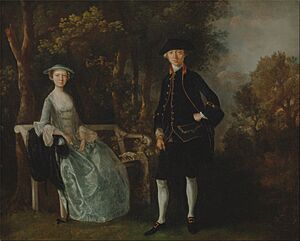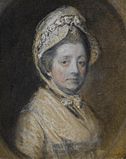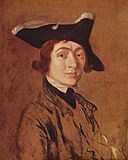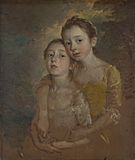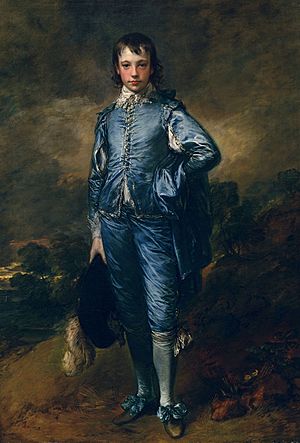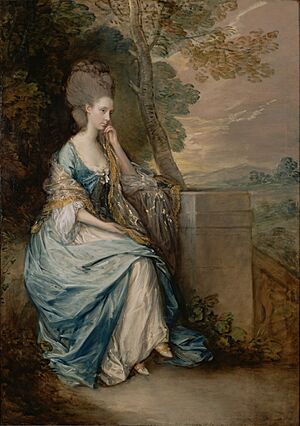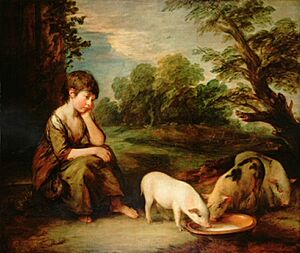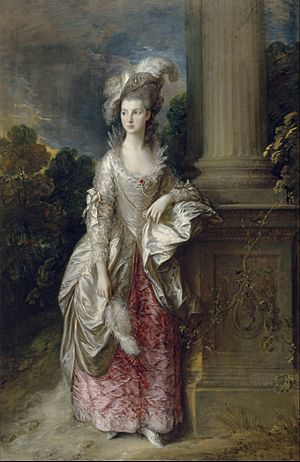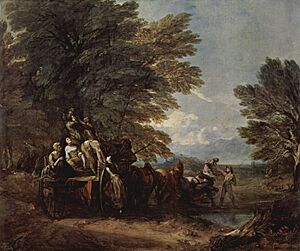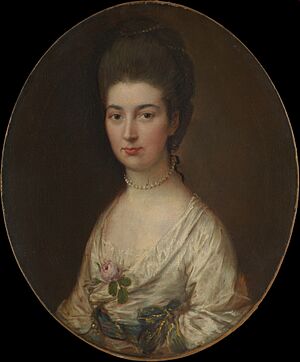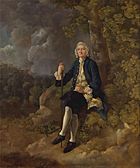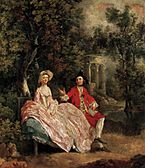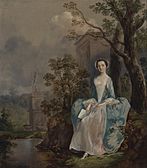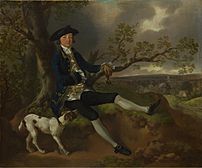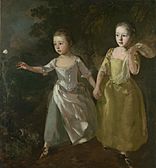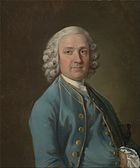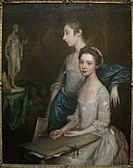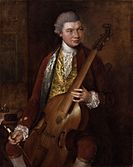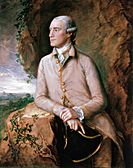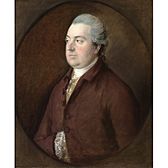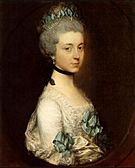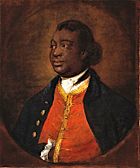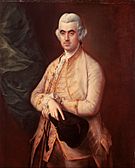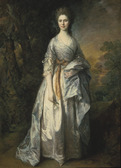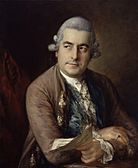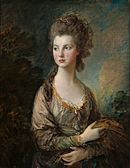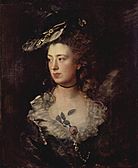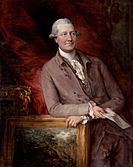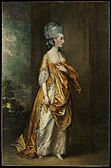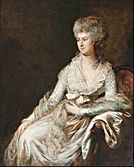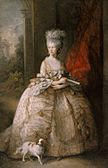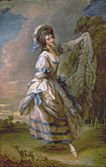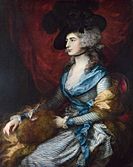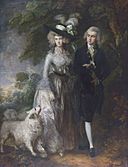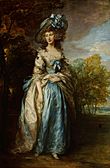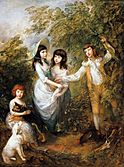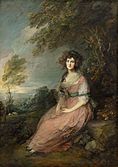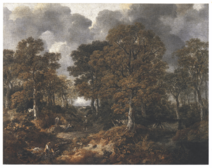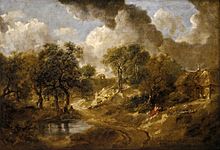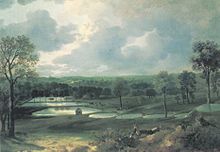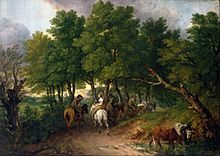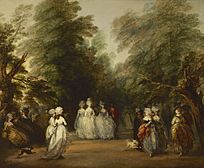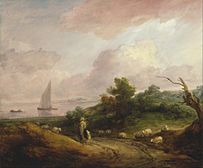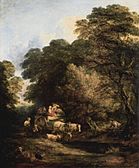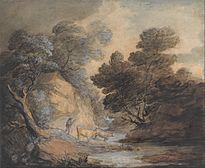Thomas Gainsborough facts for kids
Quick facts for kids
Thomas Gainsborough
|
|
|---|---|

Self-portrait (1759)
|
|
| Born | |
| Died | 2 August 1788 (aged 61) London, England
|
| Resting place | St Anne's Church, Kew |
| Education | Hubert-François Gravelot, Francis Hayman |
| Known for |
|
|
Notable work
|
Mr and Mrs Andrews The Blue Boy |
| Movement | Rococo |
| Spouse(s) |
Margaret Burr
(m. 1746) |
Thomas Gainsborough (born May 14, 1727, died August 2, 1788) was a famous English painter. He was known for his amazing portraits of people and beautiful landscape paintings. Along with another artist named Joshua Reynolds, Gainsborough was one of the most important British artists in the late 1700s.
He painted very quickly, and his later works are known for their bright colors and easy, flowing brushstrokes. Even though he painted many portraits, Gainsborough loved painting landscapes the most. He is considered one of the first artists to create the British landscape painting style in the 18th century. Gainsborough also helped start the Royal Academy of Arts, a famous art institution.
Contents
Early Life and Art Training
Thomas Gainsborough was born in Sudbury, Suffolk, England. He was the youngest son of John Gainsborough, who made woollen goods. Thomas showed a talent for drawing and painting from a very young age. By the time he was ten, he was already painting small portraits and landscapes.
In 1740, when he was 13, Gainsborough moved to London to study art. He trained with an engraver named Hubert-François Gravelot. An engraver is someone who carves designs onto metal plates to make prints. While in London, he also worked with other artists like William Hogarth and Francis Hayman. He even helped decorate a famous pleasure garden called Vauxhall Gardens.
His childhood home in Sudbury, Gainsborough's House, is now a museum dedicated to his life and art.
Painting Career
Suffolk Years
In 1746, Gainsborough married Margaret Burr. At first, his landscape paintings were not selling very well. So, he moved back to Sudbury in 1748 and started focusing more on painting portraits.
In 1752, he and his family, including their two daughters, Mary and Margaret, moved to Ipswich. Here, he started getting more requests for portraits. However, most of his clients were local merchants and landowners, so he still had to borrow money sometimes.
- The artist's family and self-portrait
Moving to Bath
In 1759, Gainsborough and his family moved to Bath, Somerset. Bath was a fashionable city, and he hoped to find more wealthy clients there. He studied the works of older masters like Anthony van Dyck to improve his portrait skills.
His reputation grew, and he began sending his paintings to exhibitions in London. In 1769, he was invited to become a founding member of the Royal Academy of Arts. This was a big honor! However, he didn't always get along with the Academy and stopped showing his paintings there for a while in 1773.
Even though he was successful, Gainsborough sometimes felt tired of painting portraits. He once wrote to a friend that he wished he could just paint landscapes instead. He also loved playing the viol da gamba, a musical instrument, and owned several of them.
Life in London
In 1774, Gainsborough and his family moved to London. He started exhibiting his paintings at the Royal Academy again in 1777. He painted portraits of famous people, including the Duke and Duchess of Cumberland. He also began trying out new ways to make prints, like aquatint and soft-ground etching.
During the 1770s and 1780s, Gainsborough started painting portraits where the person was part of a landscape. For example, in his painting of Frances Browne, Mrs John Douglas, he shows her reading a letter in a quiet garden. He used similar colors and brushstrokes for both the person and the background to show their connection.
In 1776, he painted a portrait of Johann Christian Bach, a famous musician and the son of Johann Sebastian Bach. This painting is now in the National Portrait Gallery, London.
In 1780, Gainsborough painted portraits of King George III and Queen Charlotte. After this, he received many more requests from the Royal Family. His daughter Molly married a musician, but the marriage didn't last long.
Even though another artist, Joshua Reynolds, became the King's main painter, Gainsborough remained the Royal Family's favorite. In his later years, Gainsborough painted many landscapes. He and Richard Wilson are considered the founders of the 18th-century British landscape painting style.
Gainsborough died of cancer on August 2, 1788, when he was 61 years old. He is buried in the churchyard of St Anne's Church, Kew.
Painting Style
Art experts describe Gainsborough as a very skilled and experimental artist for his time. He was known for how quickly he painted. He often painted by observing nature and people, rather than strictly following art rules. His paintings had a poetic feeling that made people emotional.
Gainsborough loved landscapes so much that he often blended the people in his portraits with the backgrounds. He sometimes even created miniature landscapes using stones, mirrors, and even broccoli on a tabletop, then lit them with candles to get ideas for his paintings! His later works are known for their light colors and easy, simple brushstrokes.
His nephew, Gainsborough Dupont, was his only known assistant.
Famous Works and Legacy
Some of Gainsborough's most famous paintings include The Blue Boy, Mr and Mrs Andrews, Portrait of Mrs. Graham, and The Morning Walk. These paintings show how he captured the unique personality of each person he painted.
His paintings became very popular with art collectors starting in the 1850s. Today, his works are highly valued. In 2011, one of his portraits, Miss Read, sold for a record price of over £6.5 million!
Gainsborough in Popular Culture
- Gainsborough's famous painting The Blue Boy appears in the 1988 comedy movie The Naked Gun: From the Files of Police Squad!.
- A play called Gainsborough's Girls is about the artist's life in London in 1774.
- The 1975 film Barry Lyndon was inspired by Gainsborough's paintings and other 18th-century artists.
- His painting The Morning Walk can be seen in the 2012 James Bond film Skyfall.
Gallery
- Portraits
-
Clayton Jones (1745), Yale Center for British Art
-
Conversation in a Park, (1746), Louvre
-
Portrait of John Plampin, (1752), National Gallery
-
Portrait of the Artist's Daughters, 1763-64 Worcester Art Museum
-
Portrait of the Composer Carl Friedrich Abel with his Viola da Gamba (around 1765), National Portrait Gallery
-
Portrait of Ignatius Sancho, (1768), National Gallery of Canada
-
Sir Robert Clayton (1769), Walker Art Gallery
-
The Linley Sisters (1772), Dulwich Picture Gallery
-
Johann Christian Bach (1776), National Portrait Gallery, London
-
The Hon. Mrs. Thomas Graham (around 1775–77) National Gallery of Art
-
Gainsborough`s Daughter Mary (1777), Tate Britain
-
Portrait of James Christie (1778) J. Paul Getty Museum
-
Colonel John Bullock (around 1780), Blanton Museum of Art
-
An officer of the 4th Regiment of Foot (around 1776–1780), National Gallery of Victoria
-
Lady in Blue (around 1780), Hermitage Museum
-
Queen Charlotte, (around 1781) Royal Collection
-
Portrait of Giovanna Baccelli, (around 1782), Tate Britain
-
Mrs. Sarah Siddons (1785), National Gallery
-
The Cottage Girl (1785), National Gallery of Ireland
-
Portrait of Sophia Charlotte Digby, Lady Sheffield, (around 1785–86), Waddesdon Manor
-
Portrait of Georgiana, Duchess of Devonshire, (1787), Chatsworth House
-
Mrs Richard Brinsley Sheridan (1787), National Gallery of Art
- Landscapes
-
Landscape in Suffolk (1748), Kunsthistorisches Museum
-
Holywells Park, Ipswich, (around 1748–50), Christchurch Mansion
-
Mr and Mrs Andrews, (around 1750), National Gallery
-
Road from Market, (around 1767–68), Toledo Museum of Art
-
The Mall in St. James's Park, (1783), Frick Collection
-
The Harvest Wagon, (1784), Art Gallery of Ontario
See also
 In Spanish: Thomas Gainsborough para niños
In Spanish: Thomas Gainsborough para niños
- Gainsborough's House
- Fancy picture
- Rococo
- Humphrey Gainsborough
- Holywells Park


